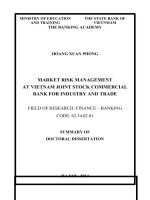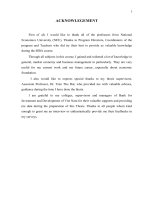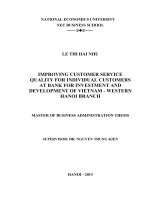Expand capital mobilization activities at viet nam joint stock commercial bank for investment and development of hai ba trung branch
Bạn đang xem bản rút gọn của tài liệu. Xem và tải ngay bản đầy đủ của tài liệu tại đây (1.14 MB, 95 trang )
ĐẠI HỌC QUỐC GIA HÀ NỘI
KHOA QUẢN TRỊ VÀ KINH DOANH
---------------------
NGUYỄN THỊ HƢƠNG
EXPAND CAPITAL MOBILIZATION ACTIVITIES AT VIET NAM JOINT
STOCK COMMERCIAL BANK FOR INVESTMENT AND DEVELOPMENT
OF HAI BA TRUNG BRANCH.
MỞ RỘNG HOẠT ĐỘNG HUY ĐỘNG VỐN TẠI NGÂN HÀNG THƢƠNG
MẠI CỔ PHẦN ĐẦU TƢ VÀ PHÁT TRIỂN VIỆT NAM – CHI NHÁNH HAI
BÀ TRƢNG
LUẬN VĂN THẠC SĨ QUẢN TRỊ KINH DOANH
HÀ NỘI - 2021
ĐẠI HỌC QUỐC GIA HÀ NỘI
KHOA QUẢN TRỊ VÀ KINH DOANH
---------------------
NGUYỄN THỊ HƢƠNG
EXPAND CAPITAL MOBILIZATION ACTIVITIES AT VIET NAM JOINT
STOCK COMMERCIAL BANK FOR INVESTMENT AND DEVELOPMENT
OF HAI BA TRUNG BRANCH.
MỞ RỘNG HOẠT ĐỘNG HUY ĐỘNG VỐN TẠI NGÂN HÀNG THƢƠNG
MẠI CỔ PHẦN ĐẦU TƢ VÀ PHÁT TRIỂN VIỆT NAM – CHI NHÁNH HAI
BÀ TRƢNG
Chuyên ngành: Quản trị kinh doanh
Mã số: 8340101.01
LUẬN VĂN THẠC SĨ QUẢN TRỊ KINH DOANH
NGƢỜI HƢỚNG DẪN KHOA HỌC: PGS.TS. HỒNG ĐÌNH PHI
HÀ NỘI - 2021
DECLARATION
The author confirms that the research outcome in the thesis is the result of author’s
independent work during study and research period and it is not yet published in
other’s research and article.The other’s research result and documentation
(extraction, table, figure, formula, and other document) used in the thesis are cited
properly and the permission (if required) is given.The author is responsible in front
of the Thesis Assessment Committee, Hanoi School of Business, and the laws for
above-mentioned declaration.
Date…………………………..
1
ACKNOWLEDGEMENT
To complete this dissertation, besides the efforts of myself, there is the enthusiastic
help of teachers, the unit where the author works as well as the encouragement of
family and friends throughout. study and research time.
The author would like to express deep thanks to Associate Professor Associate
Professor Dr. Hoang Dinh Phi for helping the author during the course of study,
orientation and writing. The author would like to thank the working unit - BIDV Hai
Ba Trung branch for creating the best conditions for the author to have the opportunity
to work and learn from practical experience. Finally, the author would like to thank
family, friends, colleagues for their support and encouragement throughout the learning
and research process to implement the project in a complete way.
Sincerely thank!
Ha Noi, May 2020
NGUYỄN THỊ HƢƠNG
2
CONTENT
LIST OF TABLES, CHART, CHART, DRAWINGS ................................................ i
LIST OF FIGURE .......................................................................................................ii
FOREWORD .............................................................................................................. 1
CHAPTER 1 RATIONALE FOR EXPANDING CAPITAL MOBILIZAION
ACTIVITIES AT COMMERCIAL BANKS .............................................................. 4
1.1 Capital mobilization activities at commercial banks ............................................4
1.1.1 Activities of commercial banks ..........................................................................4
1.1.2. Capital sources of commercial banks ................................................................5
1.1.3 Concept of capital mobilization activities and forms of capital mobilization at
commercial banks ........................................................................................................8
1.1.4 Differences between the capital mobilization of the branch and the capital
transfer of the Head Office. .......................................................................................13
1.2 Expanding capital mobilization activities at commercial banks .........................17
1.2.1 The concept of capital mobilization expansion and the need for capital
mobilization expansion .............................................................................................17
1.2.2 Criteria for evaluating the deposit mobilization of commercial banks ............19
1.2.3 Factors affecting the expansion of capital mobilization at commercial banks 22
1.3 Lesson learned on expanding capital mobilization at commercial banks ...........28
1.3.1 Experience in expanding capital mobilization at a number of banks and bank
branches in the system ..............................................................................................28
1.3.2 Lessons learned for Joint Stock Commercial Bank for Investment and
Development of Vietnam - Hai Ba Trung branch .....................................................31
CHAPTER 2 .............................................................................................................. 34
CURRENT SITUATION OF CAPITAL MOBILIZATION AT VIETNAM BANK
FOR INVESTMENT AND DEVELOPMENT OF VIETNAM - BRANCH HAI BA
TRUNG ..................................................................................................................... 34
3
2.1 Overview of Vietnam Investment and Development Joint Stock Commercial
Bank - Hai Ba Trung Branch ....................................................................................34
2.1.1 Introduction of Vietnam Investment and Development Joint Stock
Commercial Bank - Hai Ba Trung Branch ................................................................34
2.1.2 Business performance of Vietnam Investment and Development Joint Stock
Commercial Bank - Hai Ba Trung branch ................................................................36
2.2 Situation of raising capital mobilization at Joint Stock Commercial Bank for
Investment and Development of Vietnam - Hai Ba Trung branch ...........................40
2.2.1 Capital types and products ...............................................................................40
2.2.2 Capital raising scale .........................................................................................42
2.2.3 Capital structure ...............................................................................................45
2.2.4 Term of mobilized capital ................................................................................49
2.2.5 The cost of capital ............................................................................................50
2.3 Evaluate the expansion of capital mobilization activities at Vietnam Investment and
Development Joint Stock Commercial Bank - Hai Ba Trung Branch ...........................51
2.3.1 Achievements and causes .................................................................................51
2.3.2 Limitations need to be overcome .....................................................................54
2.3.3 The cause of the restriction ..............................................................................57
CHAPTER 3 .............................................................................................................. 62
SOLUTIONS TO EXPAND CAPITAL ACTIVITIES ............................................ 62
AT THE BANK FOR INVESTMENT AND DEVELOPMENT OF VIET NAM HAI BA TRUNG BRANCH ..................................................................................... 62
3.1 Business orientation of the branch in the period of 2020-2023 ..........................62
3.1.1 Assess the competitive situation and strengths of the branch: .........................62
3.1.2 General orientations for the period 2020-2023 ................................................64
3.2 Solution to expand capital mobilization activities at Vietnam Investment and
Development Joint Stock Commercial Bank - Hai Ba Trung Branch ......................66
3.2.1 Identify proper general direction and develop specific capital raising strategies
...................................................................................................................................66
4
3.2.2 Promote comprehensive and synchronous deployment of capital mobilization
products as well as other services and products ........................................................68
3.2.3 Develop customer care policies, especially important customers ...................71
3.2.4 Research and carry out the shift from the traditional banking model depending
on the branch network to the digital banking model. ................................................71
3.2.5 Strengthen training as well as focus on personnel policies at the branch ........73
3.2.6 Renovating facilities, equipment as well as finding a new location for the
transaction room ........................................................................................................75
3.2.7 Strengthen media marketing, product and brand promotion ...........................76
3.3 Proposals to the Bank for Investment and Development of Vietnam .................78
CONCLUSION ......................................................................................................... 82
LIST OF REFERENCES .......................................................................................... 85
5
LIST OF TABLES, CHART, CHART, DRAWINGS
Table 2.1: Business operation targets .......................................................................37
Table 2.2: Scale of mobilized capital ........................................................................42
Table 2.3: Capital mobilization scale of 5 branches .................................................44
Table 2.3: Capital structure by customer type ..........................................................45
Table 2.4: Structure of mobilized funds by currency................................................48
Table 2.5: Capital mobilized by term ........................................................................49
Table 2.6 Table of interest difference between capital trading .................................51
i
LIST OF FIGURE
Figure 1.1: Illustration of old capital management mechanism ................................14
Figure 1.2: Illustration of centralized capital management mechanism ...................16
Chart 2.1: Organizational structure of BIDV, Hai Ba Trung branch ........................35
Figure 2.1: Mobilized capital scale ...........................................................................43
Figure 2.2: Capital mobilization scale of 5 branches ................................................44
Figure2.3: Proportion of deposits by customer groups .............................................47
Figure 2.4: Capital mobilized by term ......................................................................50
ii
FOREWORD
1. Rationale
In recent years, the competition of the banking system has become increasingly
fierce. Not only competition among banks but also within the bank itself, among
branches in the province to promote and develop banking services, including capital
mobilization. Capital is an extremely important input to economic activities and is
especially important for the banking system. In the trend of globalization and the
4.0 industrial revolution, it has shown more importance besides human, technology
and natural resources inputs. As a developing country, Vietnam's capital needs are
immense for growth and development. The banking system is considered as the
main bridge to mobilize capital and provide for the economy.
Customers have more information and increasingly stringent requirements about the
quality of services and benefits that the bank brings. Besides, the forms of
investment are likely to bring higher profits such as real estate, securities,
commercial business ... giving customers more choices..
Joint Stock Commercial Bank for Investment and Development of Vietnam is one
of the largest banks in the Vietnamese banking system with a long history of
operation and a strong brand. BIDV Hai Ba Trung Branch is located in one of the
central districts of Hanoi, where the population is densely populated, businesses,
development services and the population are quite high. In addition, in three
consecutive years from 2017 to 2020, the branch will be recognized as one of the 30
key branches of BIDV and its orientation will continue to be one of the key
branches of the system for the period 2020 - 2025. However, the capital
mobilization scale of the branch is quite small compared to other branches in the
area and tends to decrease, grow slowly and unstable in recent years, the customer
base is not really stable and There are no target customers to exploit. In 2017, the
capital mobilization scale of the branch was over VND 11,050 billion, 2018 was
VND 12,200 billion and in 2019, the growth rate reached over VND 13,800 billion,
however, the business plan was not completed. and the scale is low compared to
1
branches with similar operating conditions. In order to complete the business plan,
as well as expand the money from customers to mobilize the scale to match its
potential and position, the branch needs to take advantage of the position and
human resources, brands to scale up capital mobilization. Recognizing the urgency
of the problem, the author chose the topic "Expanding capital mobilization
activities at Joint Stock Commercial Bank for Investment and Development of
Vietnam - Hai Ba Trung Branch" as the research topic for his thesis
2. Aims of research
The research topic aims at the following objectives:
General goal: Expanding capital mobilization activities at BIDV Hai Ba Trung branch
Detail goal:
The topic of systematizing basic theories about capital mobilization activities at
commercial banks, the role of capital mobilization activities and the factors
affecting the capital mobilization expansion..
Analyze the situation of capital mobilization at BIDV Hai Ba Trung branch
Evaluate strengths and weaknesses of capital mobilization activities at the branch.
Based on the evaluation of the situation of raising capital at the branch, proposing
solutions and recommendations to expand capital raising activities at BIDV Hai Ba
Trung branch.
3.Object and scope of research
Object of research: Capital mobilization activities at commercial banks
Scope of research:
Research content: deposit mobilization activities with customers who are
individuals, businesses and financial institutions..
Research space: capital raising activities at BIDV Hai Ba Trung branch..
Research period: 2017 - 2019 period.
4. Research methodology
Primary data was collected by the author through in-depth interviews of Sales
Manager of the branch, 5 important customers and 5 customer transaction officers.
2
Secondary data collected by the author from: internal sources collected by the
author via business reports, summary reports, and internal manuals; From external
sources, the author collected via the internet is the website of BIDV and some other
banks, related articles, web portal of Hanoi City, final report of the Bank of
Vietnam country.
Regarding data processing method: the author uses descriptive statistical methods,
compares excel tables, frequency tables, charts.
5. Thesis structure
Chapter 1: Rationale for expanding capital mobilization activities at commercial
banks
Chapter 2: The situation of raising capital mobilization at Joint Stock Commercial
Bank for Investment and Development of Vietnam - Hai Ba Trung branch
Chapter 3: Solutions to expand capital mobilization activities at Vietnam
Investment and Development Joint Stock Commercial Bank - Hai Ba Trung Branch
CONCLUSION
3
CHAPTER 1
RATIONALE FOR EXPANDING CAPITAL MOBILIZAION ACTIVITIES
AT COMMERCIAL BANKS
1.1 Capital mobilization activities at commercial banks
1.1.1 Activities of commercial banks
As one of the economy's most important financial intermediaries, the
bank offers the most diverse, complex, and functional financial services of any
business in the economy. The type of goods traded by commercial banks is
currency - a very special commodity, with such special and complex nature, so
far there is no unified definition of the bank, depending on the development
conditions. Countries have a different definition. Along with the development
of the financial system, the banking system has helped diversify capital
channels and help money flow better.
Corresponding
to
the
different
economic,
political
and
social
development conditions that the economy divides into many types of banks.
According to the amended Law on Credit Institutions (2017), in terms of goals
and nature of operation, they can be divided into policy banks, cooperative
banks and commercial banks of which commercial banks account for the
largest proportion. Each country in the world has a different definition of
commercial banks, but they all have common features. According to the
amended Law on Credit Institutions (2017): “Commercial banks are the type of
banks that perform all banking activities. goods and other business activities
specified in this Law for profit-making purposes "can be divided into:
- Receiving deposits: Also known as capital mobilization, this is one of
the first basic activities of commercial banks. Individuals and economic
organizations having idle money, deposited in banks, commercial banks can
use those idle money to perform various business purposes, at the same time
committing to pay principal and interest. to customers according to a prior
4
agreement. The methods of mobilizing are very diverse, depending on the
management and use methods, such as deposits, deposits, valuable papers,
etc.…
- Credit extension: The capital that the bank can mobilize can be used
for many different business purposes, mainly for lending. And now commercial
banks have expanded their lending activities into credit operations, or lending,
that is, between the bank and the customer with an agreement whereby the
customer can use or be committed by the bank. allows the use of a sum of
money, on the principle of credit reimbursement. Credit operations include:
lending, discounting, financial leasing, factoring, bank guarantee and other
credit activities
- Provide payment services through accounts: it is the supply of payment
facilities, implementation of payment services for checks, bank cards, collection orders,
payment orders, collection orders, letters of credit. and other payment services.
Account-based payment services help increase the utility of the bank, thereby
promoting capital mobilization activities as well as bank credit..
It can be said that commercial banks are a very important channel of
capital, a bridge between individuals, businesses and the economy. Today,
along with the development of the socio-economy, the forms of mobilization
are increasingly diverse and plentiful, meeting the demands of depositors as
well as the increasing requirements of customers.
1.1.2. Capital sources of commercial banks
There are many ways to divide the capital of commercial banks to suit the
purpose of management and use. According to that property, it is possible to divide
the capital sources of commercial banks as follows:
1.1.2.1 Equity
- Equity is the capital contributed by the owners in the beginning and can be
added in the course of business operations. Equity only accounts for a small
proportion, about 5-10% of the total capital of commercial banks. This capital
5
source is highly stable, so the Bank often uses it to finance fixed assets such as
equipping long-term assets, investing in technical facilities and equity, and equity is
often not used for lending because waste. Although the proportion is small, equity is
very important, it is the foundation for the bank to organize its business activities.
Equity includes:
- Initial capital formation: it is the initial capital contribution when
establishing a bank, this is also the basis for banks to ensure legal conditions upon
establishment. Depending on the nature of ownership, the capital contribution is
also diverse: with the state bank, the capital allocated by the State budget, the jointstock bank is contributed by the shareholders, the private bank belongs to private
ownership, a joint venture bank, is contributed by the joint venture parties
- Initial capital formation: it is the initial capital contribution when
establishing a bank, this is also the basis for banks to ensure legal conditions upon
establishment. Depending on the nature of ownership, the capital contribution is
also diverse: with the state bank, the capital allocated by the State budget, the jointstock bank is contributed by the shareholders, the private bank belongs to private
ownership, a joint venture bank, is contributed by the joint venture parties…
- Additional capital in the course of business operations: in order to expand
the scale of operations, purchase new equipment or the central bank requires an
increase in equity, this capital source may be formed from the profits of banks,
issuance of additional shares, shares, additional capital ... The nature of this capital
is infrequent, depending on the business situation, operating conditions that banks
choose the appropriate form of additional capital.
- Funds: depending on the purpose of use and regulations of credit
institutions, banks may set up different funds such as reserve fund for charter
capital supplement, capital preservation fund, welfare reward fund, reserve
fund. risk prevention, fixed asset depreciation fund, etc. These funds are
deducted from the bank's operating profit.
-
6
1.1.2.2 Debt capital
Debt capital accounts for a major proportion in the total capital of commercial
banks and the debt capital business constitutes the main source of income of banks.
Debt capital included:
- Source of deposits: this is the main source of debt. The Bank mobilizes
deposits from individuals and organizations through deposit products, and also
provides utility products and services to customers. The deposit is essentially owned
by the customer, the bank only holds it and has the right to use it for business, not
ownership. The bank will commit to pay the principal and interest to customers on
time as committed, besides providing payment services for some deposit products.
- Borrowing source: in business activities, the capital source of the bank will
be in excess or shortage at that time, commercial banks can borrow more from the State
Bank, credit institutions or borrow from the interbank market. The borrowing from
commercial banks also depends on the monetary policy of each period from which the
SBV decides the appropriate amount, interest rate and loan level. Commercial banks can
borrow to meet the solvency of the bank, lend money to customers, borrow to re-lend or
balance the cost of money sources for the next period.
- Other debt sources: money in payment, entrusted capital ... In non-cash
payments, sources of money in temporary payment are idle such as L / C opening
deposit, check during payment process ... Some banks function as correspondent
banks, then the trust investment capital is entrusted by the financial institutions to
the bank for lending to its projects, or loans. government. Besides, other amounts
such as unpaid wages, taxes, fees, insurance ... not yet paid for the budget are
temporary idle amounts that the bank can balance using.
-In the debt capital, deposits are the most important source of commercial
banks, the size of deposits often accounts for more than 50% of total capital and
accounts for about 70% of debt capital, deposits are also the growth target of
commercial banks.
7
1.1.3 Concept of capital mobilization activities and forms of capital mobilization
at commercial banks
Regardless of the classification, raising capital is one of the first and most
basic operations.
“Capital mobilization activities of a credit institution are generally
understood as the use by the credit institution of its deposit taking, issuance of
valuable papers, payment and other banking operations to mobilize. mobilizing
temporary capital in the economy ”...
There are many ways of dividing the mobilization forms, to facilitate the
bank's management and use of capital, besides, customers will easily choose
appropriate purposes and their spending plans. And with certain deposits, the bank
can use many criteria to manage. We can divide the forms of capital mobilization
according to the following criteria:
1.1.3.1 Over the term
Deadline is one of the most important factors for each deposit for both
banks and customers. With the bank, always having to ensure liquidity, so
managing capital over time will help the bank have a better plan of using capital.
And customers, will have the option to send the deposit in accordance with the plan
of spending and using your capital. Over time, it can be divided into forms of
mobilizing demand deposits and term deposits.
- Non-term capital sources, such as demand deposits, demand savings
deposits, securities trading deposits, margin deposits, etc. These funds have
indefinite term, interest rates paid by banks. This source of capital is also very low,
often floating by the market. These deposits are deposited at banks for the purpose
of keeping money or for payment transactions, which can be withdrawn or debited
at any time, so customers are less interested in the interest rates that banks spend.
pay. Although the cost is cheap, this capital source is of low stability, so the bank
has to calculate carefully to ensure liquidity. In addition, to attract customers, banks
8
often enhance features and utilities in payment services to facilitate customers to
use the service
- Term deposits, such as term savings accounts, time deposits, valuable
papers, etc. Term deposits are deposits of organizations and individuals that are
verified in the form of deposit contracts or via electronic means. Savings deposit is an
individual's deposit which is verified in the form of a savings book. The above products
are subject to prior agreement between the bank and the customer on the interest rate,
term, method of withdrawal and higher stability so the interest rate paid for those
products is usually higher, the bank may be more proactive in using this capital for
business. The term of these products varies, from 1 to 12 months, 13 months, 15
months, 18 months, 2 years, 3 years ... and usually the longer the term the interest rate
the bank will pay, the higher, encourage customers to send long term These products
often stipulate that customers who are not allowed to withdraw prior to maturity, or
withdraw prior to maturity will receive only demand interest rate.
1.1.3.2 According to the mobilization tool
According to the mobilization tool, it can be divided into deposits from
deposits, loans from loans, and deposits from issuance of valuable papers.
-Deposit mobilization: receiving deposits is the main form of mobilization by
banks. The bank must reserve required deposits, so the cost of mobilization will be
pushed up. Deposits include: demand deposits, term deposits, and savings deposits.
Deposit
payment:
pressure
objects
are
including
individuals
and
organizations. With payment deposits, customers open for bank keeping and
perform payment purposes such as payment, withdrawal, payment order, issuing
checks, and associating with ATM cards. The characteristics of payment deposits
are not stable, customers can deposit and withdraw at any time to fulfill the
transaction needs and the bank must always meet. The interest rate paid for payment
deposits may not be available or very low and customers may incur some costs to
maintain the operation of the account such as account management fees, annual card
fees ... according to the policies of each bank. Because the main purpose is payment
9
so what customers care when opening a payment deposit account is accuracy, fast,
convenient. Therefore, banks attach great importance to investing in equipment,
quick payment systems and linking with many domestic and international
organizations in order to bring convenience to customers, besides banks Customers
can collect account management fees, send and receive messages, issue card fees ...
and take advantage of short-term payment deposits.
Term deposits: the object of this form is individuals and organizations but in
fact depositors are mostly organizations. Economic organizations with idle, unused
funds such as unpaid wages, unused funds will have an agreement with the bank to
return it with a certain time limit. The interest rates paid by banks are higher and the
stability of term deposits is higher than that of current accounts. The purpose of this
deposit is to enjoy interest and bank keeping, not for payment. Term deposits are
usually agreed in the form of deposit contracts, statements or confirmation via
electronic means. According to the Law on Deposit Insurance (2012) - Decision No.
527 / QD-TTg dated April 1, 2016 of the Prime Minister on amending and
supplementing a number of articles of the Regulation on organization and operation
of Bao Deposit Insurance issued together with the Prime Minister's Decision No.
1395 / QD-TTg of August 13, 2013, deposits of individuals are insured in accordance
with regulations on deposit insurance, and deposits of organization not covered..
- Savings deposit: is the amount of money that individuals deposit into a
savings account, this form of payment is usually verified through savings books or
savings certificates. Savings account will enjoy higher interest rates than other types
depending on deposit term and be insured in accordance with deposit insurance
regulations. Savings deposit accounts include demand deposits and term deposits.
With demand deposit, customers can deposit or withdraw at any time, the interest
rate paid for this item is usually very low, the balance is usually small. With term
savings deposit, there is a prior agreement between the customer and the bank on
the term, the amount, interest rate and the customer must not withdraw before the
due date. The characteristic of term savings accounts is that the interest rate is high
10
and the stability is higher, so the bank is more active in using, especially for longterm purposes. In fact, in order to increase convenience for customers and increase
the flexibility of products, some banks still allow customers to withdraw before
maturity but bear penalties, no interest or no interest. With this form, the factor that
customers are interested in is interest rates, accompanying promotions, so banks
often diversify deposit products and promotional prizes to attract customers.
- Deposit from loans: Commercial banks borrow often to meet liquidity
requirements, required reserve requirements or capital needs of high, medium and
long-term stability. First of all, commercial banks will borrow from each other, if
not, the state bank will be the last lender.
Borrow from credit institutions: commercial banks borrow from each other
or other credit institutions in the interbank money market, also known as market II.
In the course of operation, some commercial banks have compulsory reserves in
excess of the prescribed limits while some lack reserves, banks with excess reserves
will lend to banks in shortage to seek profits. The loan bank can then agree on the
interest rate, term and size of the loan by contacting the phone bank or
correspondent bank directly, resulting in the bank's reserve. borrowing increased
and bank lending decreased. The characteristics of these loans are usually shortterm, such as overnight loans or one to several weeks, the interest rate depends on
the reputation of the borrowing bank and the monetary policy of the central bank in
each period.
Borrowing from the State Bank: is often used in cases where commercial
banks are short of reserves with the main form of rediscounting. Commercial papers
that have been discounted or rediscounted by commercial banks will be brought to
rediscount at the State Bank. Documents discounted by the State Bank must not be
due, have short maturity, issued by reputable organizations, high solvency such as
bonds, treasury bills ... This operation will reduce reserves. secondary (valuable
papers) and increase primary reserves (cash or deposits at state banks). If there is no
11
negotiable instrument, the State Bank will lend to commercial banks in the form of
refinancing according to a certain limit.
- Issue valuable papers: According to Clause 2, Article 98, According to
the amended Law on Credit Institutions (2017), credit institutions are allowed to
issue certificates of deposits, promissory notes, bonds to mobilize domestic and
foreign capital. This is considered as a debt of the bank to the holder of the valuable
paper. Bills are debt certificates issued to mobilize short-term funds (less than 1
year), which are highly liquid and favored by flexibility. Bonds and valuable papers
are often used in cases of mobilizing medium and long-term capital (over 1 year).
Capital mobilized through bonds and deposit certificates has the advantage of high
stability, banks can be proactive in using capital but the disadvantage is high cost
due to higher interest rate compared to other forms.
On the valuable papers, it is often stated clearly the face value, term,
interest rate. Banks often use this method when they want to mobilize a large amount
of capital, high stability and in installments. The ability to mobilize this capital depends
heavily on the reputation of the bank and the development of the financial market.
Large commercial banks can mobilize this source more easily, while small commercial
banks often have difficulty mobilizing in this form and often do it indirectly through
correspondent or guaranteed banks. In order to issue valuable papers, commercial
banks must ask permission from regulatory agencies and must carefully research the
market to make a reasonable scale, interest rate and term.
1.1.3.3 According to the mobilization object
According to the mobilization object can be divided into businesses, individuals
or residents and other objects. This division can help commercial banks segment
customers to have appropriate policies towards specific audiences..
- Individual customers: or residential customers, usually have idle
temporary deposits into banks to accumulate or wait for plans to use, the capital
mobilized by the bank is mainly savings deposit. The goal of this customer is safe
and lucrative, so Science and Technology are very interested in the interest rate and
12
reputation of the bank, the network system to bring convenience when dealing with
customer care policies, Promotion, gifts. Capital mobilized from residents is quite
stable and is mainly from long-term sources because customers often deposit for
long periods to enjoy higher interest rates. In addition to savings deposits,
customers also open payment accounts to transact, though this source is not large,
but it is a cheap source that banks can take advantage of and collect fees through
selling banking services.
- Corporate customers: Corporate customers often deposit in the form of
deposit contracts and deposit accounts. The main objective of this object when
opening a deposit account is to use payment services, so corporate customers are
interested in the speed, convenience, transaction network, money transfer fees,
transactions and policies. flexible customers. To serve transactions, corporate
customers often maintain a certain amount of money in the account so banks can take
advantage of this source in the short term. In addition, when corporate customers are
in operation, unused amounts such as unpaid wages, unpaid insurance, investments,
procurement are in the planning ... often sign deposit contracts to To earn interest,
these funds are usually sent in short term less than 6 months.
- Other subjects: including financial institutions, banks or other credit institutions,
etc. often open accounts to meet the demand for payment and interest. The financial
institutions often have large deposit contracts at commercial banks, the capital sources
that banks mobilize through the financial institutions are often large in scale, so this
source of fluctuations will greatly affect the total capital of banks, especially small banks.
1.1.4 Differences between the capital mobilization of the branch and the capital
transfer of the Head Office.
There are 2 forms of capital management currently: under the old mechanism and
centralized capital management mechanism
1.1.4.1 Old capital management mechanism:
With this capital management mechanism, branches independently manage
capital through the focal point, branches must comply with regulations on
13
compulsory reserves, risk management and liquidity response when necessary. set.
We can imagine this capital management mechanism as follows:
Figure 1.1: Illustration of old capital management mechanism
Source: khotrithucso.com
Under this mechanism, the branches balance the capital themselves and only
transfer or receive the difference between the debt assets and the assets. And the
capital center at headquarters only receives or transfers that difference from
branches. The capital transfer interest rate is calculated only for that difference.
Branches bear all risk of interest rate, liquidity risk, balance of compulsory reserve.
The old operating mechanism has many limitations.
Firstly, the branches operate relatively independently and try to fulfill the
targets of mobilization, credit and accompanying profit so it is difficult to focus on
their strengths.
Secondly, the interest rate is not oriented on the entire capital source, the
efficiency of capital use of the whole system is not high, because the branch
balances its capital for liquidity so it always has a backlog of the amount of capital
at the bank. State-owned goods in the area are wasteful, and it is also difficult for
the head office to control sources of deposits with high interest rates.
Third, business results are not assessed equally to each branch, department
14
and individual. HSC restricts regular monitoring of the operations of each branch.
Fourthly, at the branch level, risks are not effectively managed: interest rate
risk occurs when there is a big fluctuation with interest rate of debt assets while assets
have interest rate lag, some commercial banks minimize interest rate risk by limiting
deposit rates and lending ceilings; liquidity risk occurs when customers have demand
to withdraw an amount of capital before maturity, making it difficult for branches to
pay; Credit risk is an indirect risk, when a bank officer is under pressure of
mobilizing sales and completing credit sales, there will be gaps in risk management,
appraisal and supervision. close to the use of capital leads to a high loss of capital
Fifth, there is no effective analytical model by business division. The
organizational structure of Vietnamese commercial banks now has many
progressive changes compared to the past, especially for commercial banks that
were formerly state-owned banks. This change is mainly in a way that focuses on
serving customers; Accordingly, the functional departments at the head office and
branches are set up according to certain market segments for business. For example:
corporate customer segment, individual customer department ... Many banks set
goals towards what they call "achievements" such as one-stop transactions ...
However, the organizational model This function leads to a big business
management defect that makes most of the banks mistakenly use and allocate their
resources. It is this model that eliminates the motivation for banks to perform
efficiency analysis by business division, thereby failing to achieve the goal of
serving customers by segment..
1.4.1.2 Centralized capital management mechanism
Also known as FTP (Fund transfer pricing), which will be circulated through
the capital center located at the head office of each branch is considered as a business
unit, whereby the entire source of funds mobilized by that center will buy the entire
capital - or liabilities of the business unit and sell the capital to the use of the business
unit - or the property. Income and expenses of business units are calculated on the
difference between capital sale and purchase with the head office. We can use the
15
capital operating model as follows:
Figure 1.2: Illustration of centralized capital management mechanism
Source: khotrithucso.com
Under this mechanism, when a deposit or any other source of capital, the
branch will sell all to the headquarters and when needed, the branch will buy back
from the headquarters, all transactions sent or loans are made to the head office via
the capital center based on currency, term, interest. The new capital management
mechanism has many advantages and overcomes most of the disadvantages of the
old mechanism:
Firstly, fundamentally, the balance of capital is concentrated in the head
office so that the branches can focus on promoting their business advantages,
promoting the strength of the geographical areas of branches in the regions.
different domain..
Secondly, saving capital costs because all debt assets are transferred to the
capital center, when they need to be bought back, there is no excess liquidity at the
branches. The head office can also control the cost of input capital for each item,
improve the capital efficiency of the whole system.
Third, the business results are evaluated in a fairer way for each branch
through internal capital transfer interest rates. Income of a branch is also recorded
from both sides of the balance sheet. Head office can also manage and monitor the
business activities of the branches but does not interfere deeply with the operations
of the branches.
16









